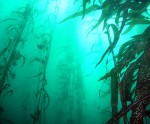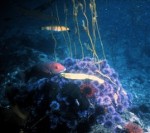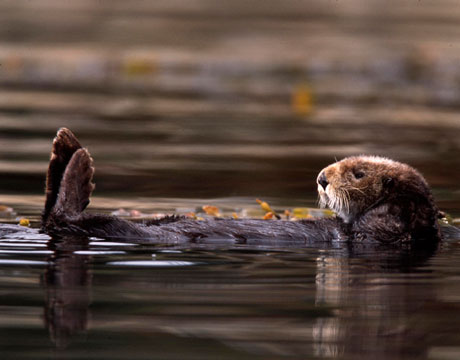 With the new challenges wildlife faces daily, it is no longer enough just to survive. To ensure species longevity, individuals must learn to quickly adapt. Although a lot of attention is given to the conservation of the large, iconic creatures of land and sea, it is often those species that reside in the middle of the food chain that play the most vital rolls in ecosystem balance that are overlooked. One particular animal that fits into this category is the sea otter.
With the new challenges wildlife faces daily, it is no longer enough just to survive. To ensure species longevity, individuals must learn to quickly adapt. Although a lot of attention is given to the conservation of the large, iconic creatures of land and sea, it is often those species that reside in the middle of the food chain that play the most vital rolls in ecosystem balance that are overlooked. One particular animal that fits into this category is the sea otter.
Like all otters, the sea otter is a member of the weasel family. The three subspecies of Enhydra lutrus can be found in coastal waters of the Pacific Ocean from northern Japan to Baja California Peninsula in Mexico. Currently, stable populations have been documented in waters on Russia’s East Coast; British Columbia, Canada; and Washington, California, and Alaska on the West Coast of the United States. Unlike other marine mammals that inhabit the same ice cold waters, sea otters do not rely on fat reserves for warmth but an exceptionally dense, waterproof fur. The very same fur coat that almost drove sea otters into extinction in the early 20th century from overhunting. However, today, the global sea otter population has increased from ~1000 individuals to 125,000. To further conservation efforts and protection they have been listed by the IUCN as a threatened species.
lutrus can be found in coastal waters of the Pacific Ocean from northern Japan to Baja California Peninsula in Mexico. Currently, stable populations have been documented in waters on Russia’s East Coast; British Columbia, Canada; and Washington, California, and Alaska on the West Coast of the United States. Unlike other marine mammals that inhabit the same ice cold waters, sea otters do not rely on fat reserves for warmth but an exceptionally dense, waterproof fur. The very same fur coat that almost drove sea otters into extinction in the early 20th century from overhunting. However, today, the global sea otter population has increased from ~1000 individuals to 125,000. To further conservation efforts and protection they have been listed by the IUCN as a threatened species.
 Sea otters are an important keystone species because of the part they play as guardians of undersea Kelp Forest. Found in temperate, polar, and even tropical waters, Kelp Forests are one of the most dynamic ecosystems. High concentrations of nutrients are found around Kelp allowing for a very diverse habitat for aquatic species; a few of which are found nowhere else in the world. In addition, Kelp Forests are known to influence coastal oceanographic patterns and have been shown to be capable of removing 10% of the CO2 from the atmosphere. The job of the sea otter within its habitat is to protect Kelp Forests by controlling the populations of kelp predators such as the sea urchin. Unchecked numbers of sea urchins can cause absolute devastation because it feeds on kelp anchor points allowing for the entire frond to float away.
Sea otters are an important keystone species because of the part they play as guardians of undersea Kelp Forest. Found in temperate, polar, and even tropical waters, Kelp Forests are one of the most dynamic ecosystems. High concentrations of nutrients are found around Kelp allowing for a very diverse habitat for aquatic species; a few of which are found nowhere else in the world. In addition, Kelp Forests are known to influence coastal oceanographic patterns and have been shown to be capable of removing 10% of the CO2 from the atmosphere. The job of the sea otter within its habitat is to protect Kelp Forests by controlling the populations of kelp predators such as the sea urchin. Unchecked numbers of sea urchins can cause absolute devastation because it feeds on kelp anchor points allowing for the entire frond to float away.
 Although the sea otter is currently protected, there are still threats to its recovery. Otters themselves are on the menu for larger species like the Killer Whale and Great White Shark, but it is their continued conflict with human activities that poses the greatest dangers. Oil pollution from spills causes sea otter’s fur to lose its insulative properties resulting in death via hypothermia. Oil ingestion and inhalation can also cause damage to liver, kidneys, and lungs. Sea otter diet consists of over 100 species of marine invertebrates, unfortunately some that are also favorites to humans as well. Conflicts with fisheries over abalone, crabs, and clams can end in death from shooting or entanglement in nets and gear. In addition, most prey items are considered “bottom feeders” and are more susceptible to contamination from toxins that bioaccumulate. Sea otters feeding on poisoned prey are consequently become ill themselves.
Although the sea otter is currently protected, there are still threats to its recovery. Otters themselves are on the menu for larger species like the Killer Whale and Great White Shark, but it is their continued conflict with human activities that poses the greatest dangers. Oil pollution from spills causes sea otter’s fur to lose its insulative properties resulting in death via hypothermia. Oil ingestion and inhalation can also cause damage to liver, kidneys, and lungs. Sea otter diet consists of over 100 species of marine invertebrates, unfortunately some that are also favorites to humans as well. Conflicts with fisheries over abalone, crabs, and clams can end in death from shooting or entanglement in nets and gear. In addition, most prey items are considered “bottom feeders” and are more susceptible to contamination from toxins that bioaccumulate. Sea otters feeding on poisoned prey are consequently become ill themselves.
